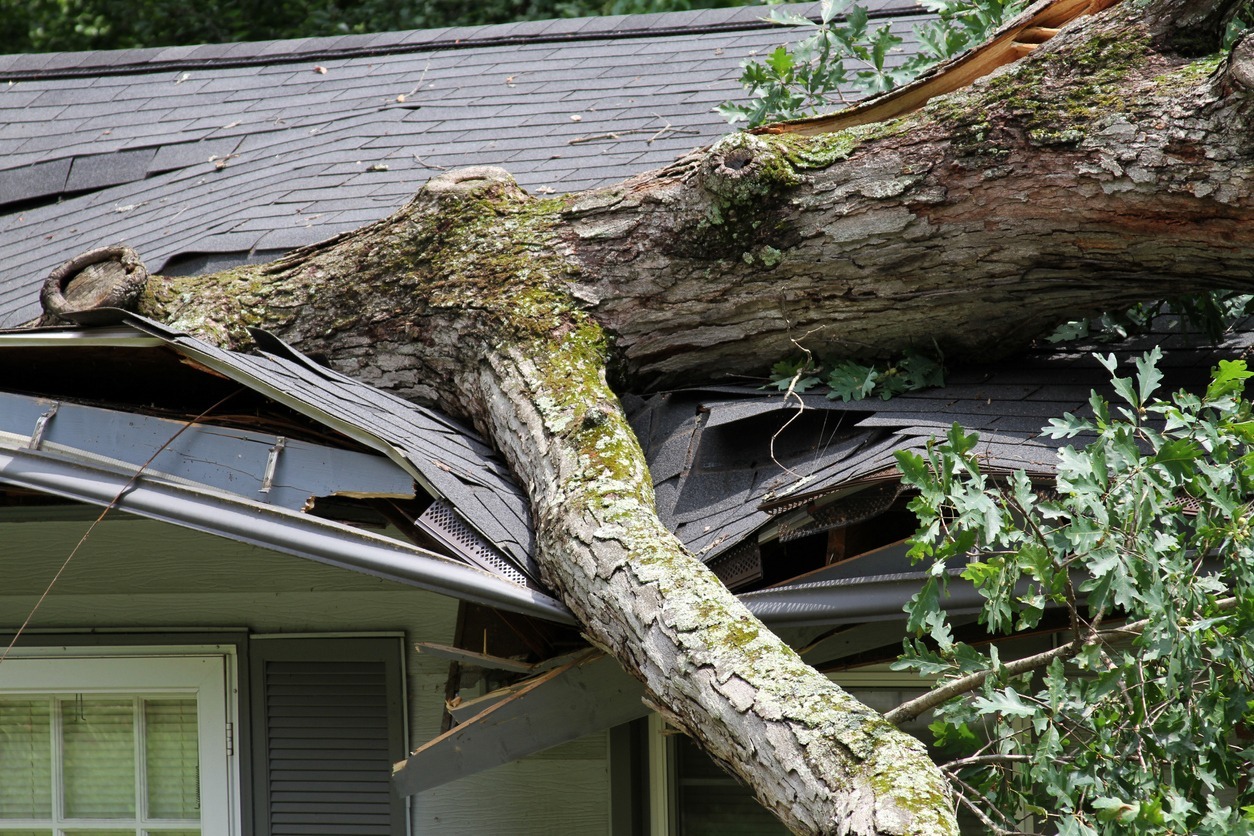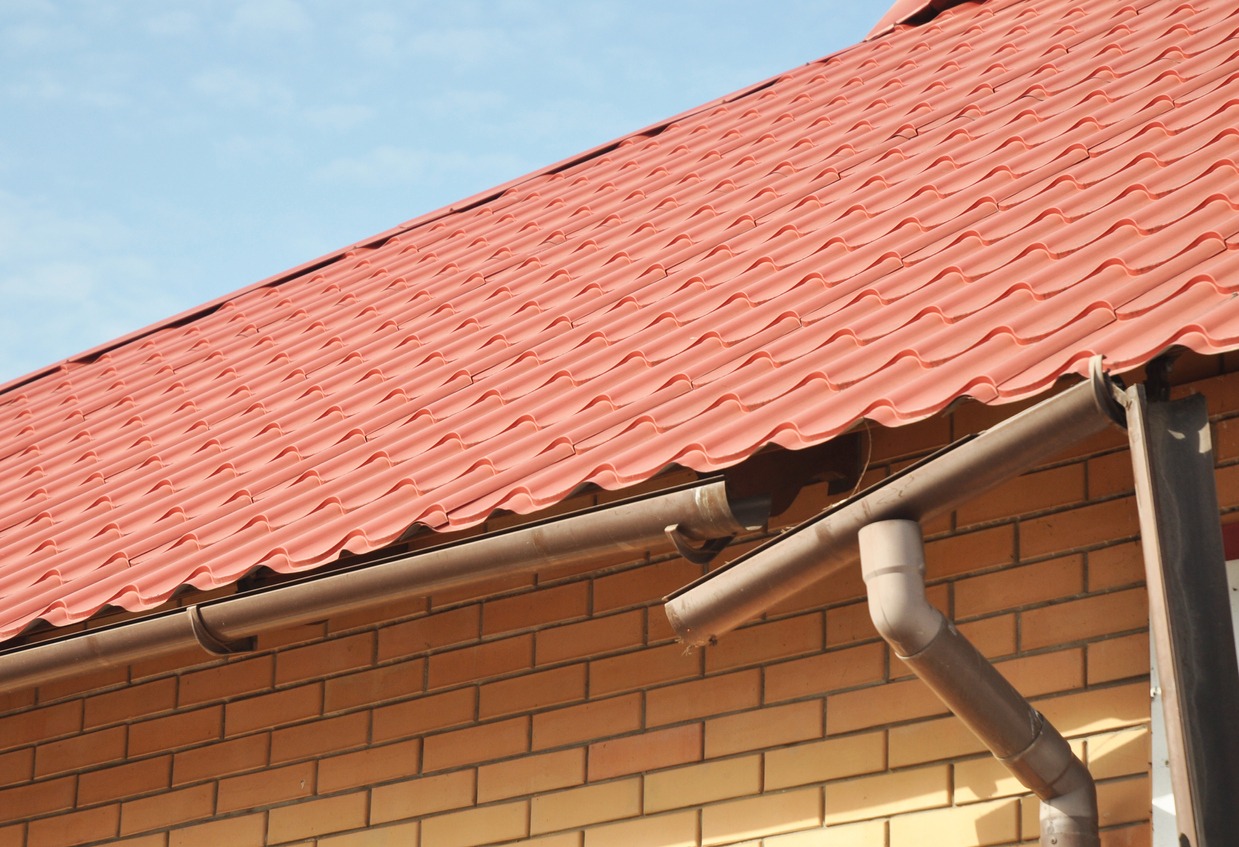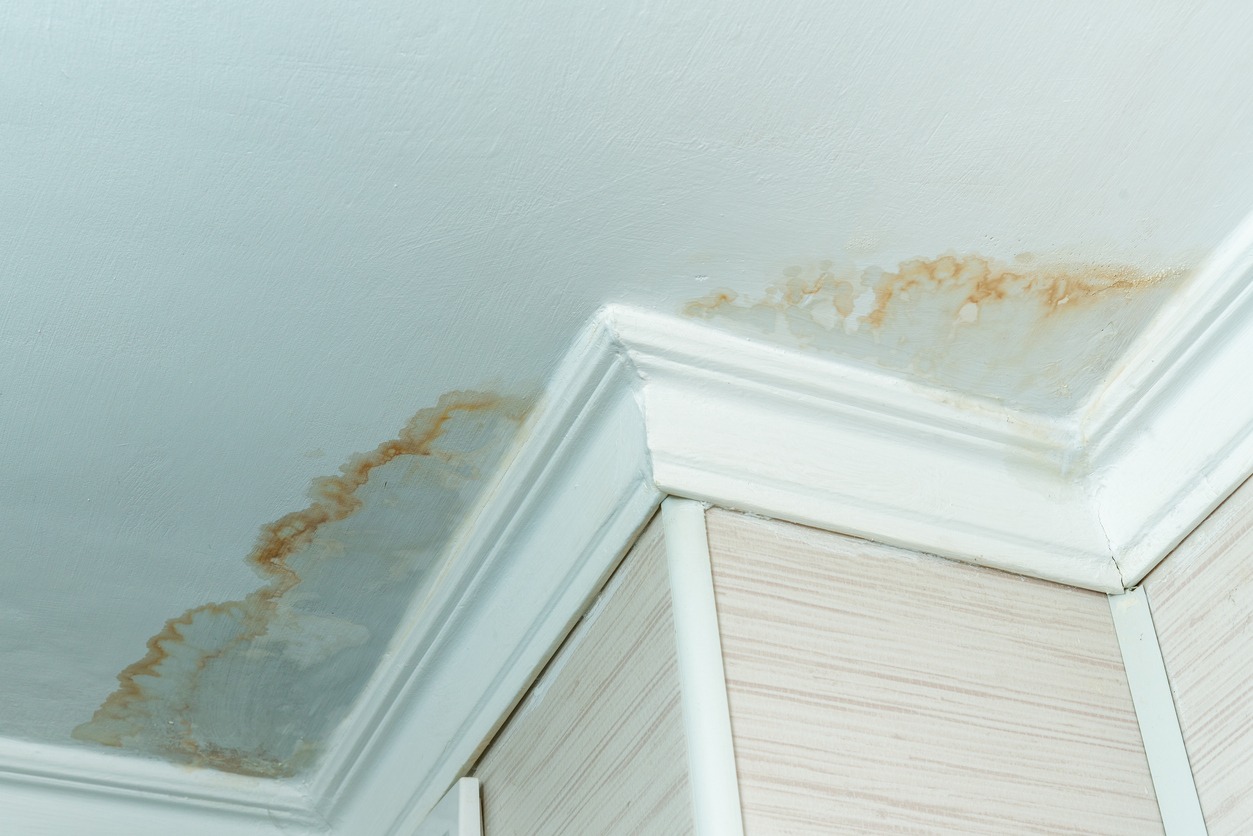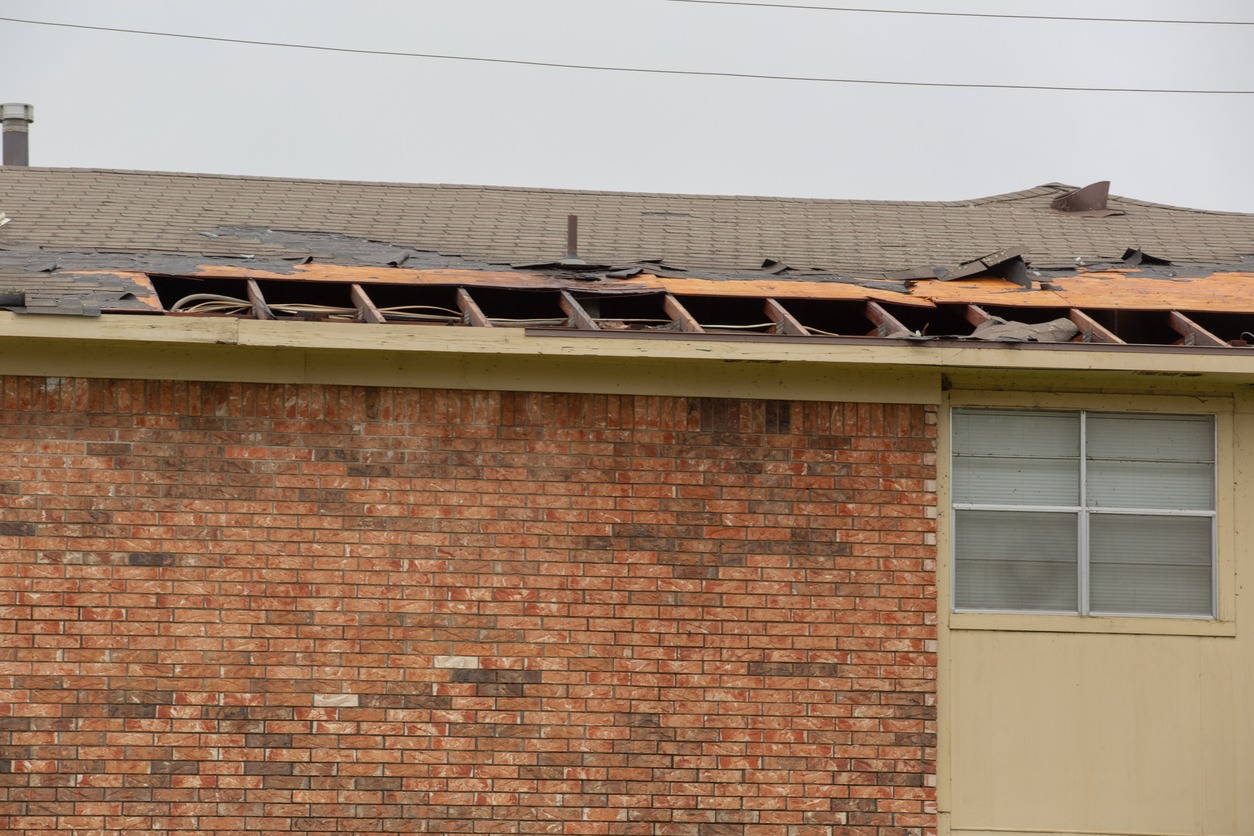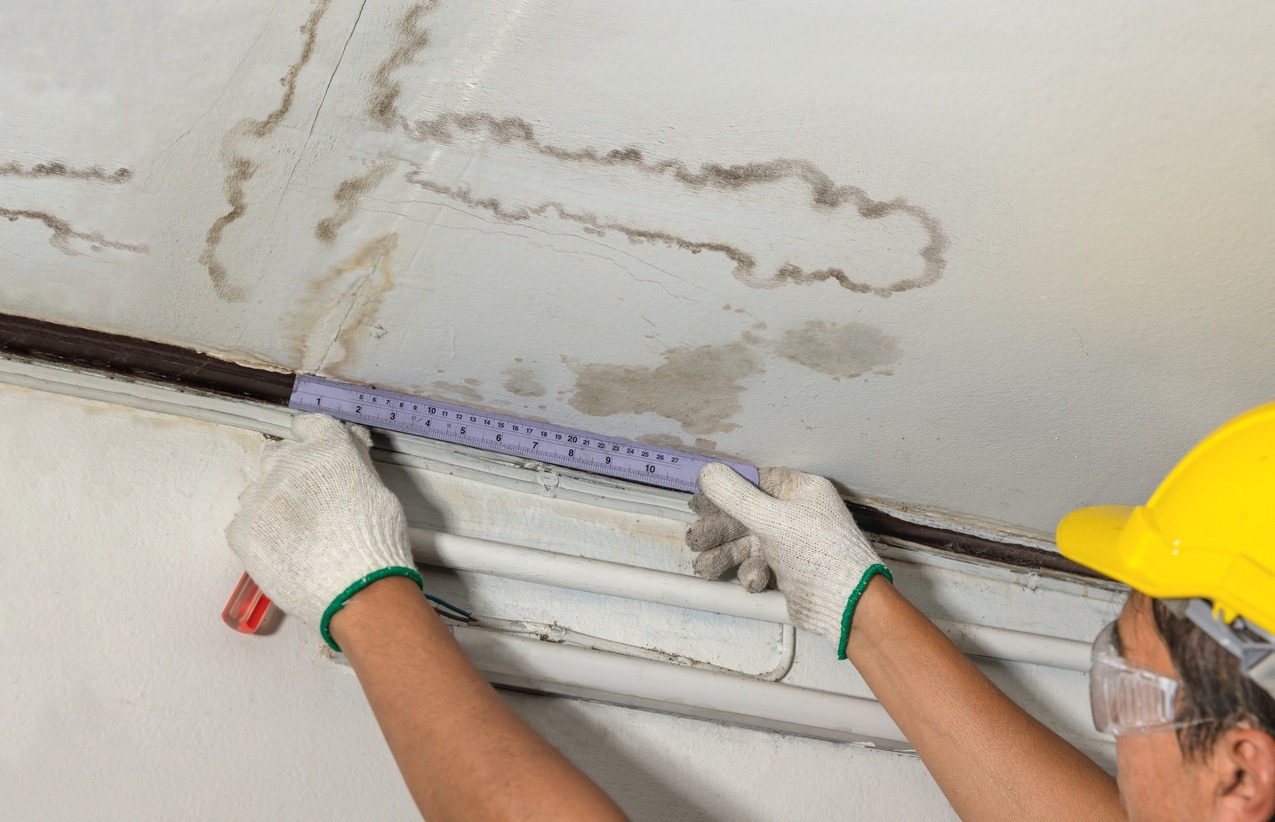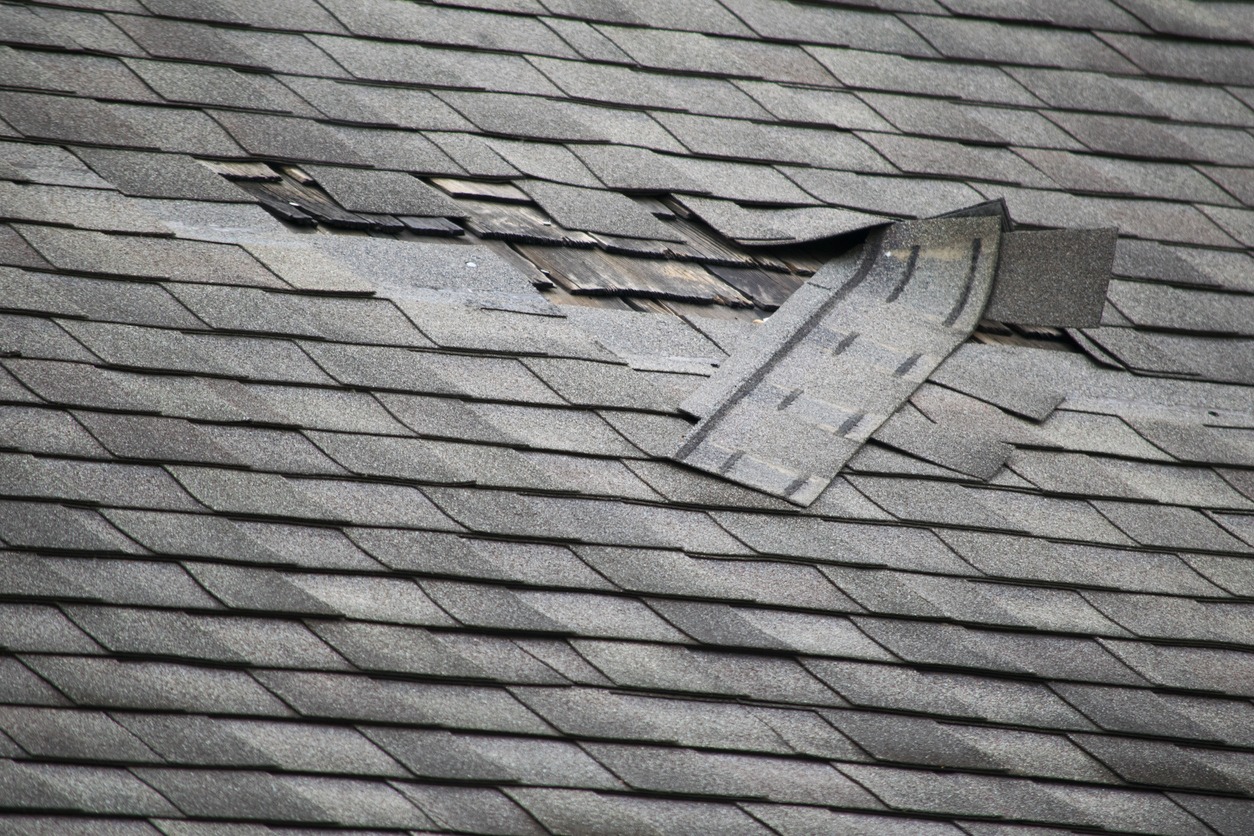Once a hurricane, hailstorm, heavy rains, or heavy snowfall has passed, you might be relieved because the storm is over. However, it’s important to check your roof for potential damage, even if there are no obvious problems like leaks or fallen trees. Wind, hail, rain, and snow can all cause various issues for your roof. Some damage is easy to see, while other problems are harder to spot—especially from a distance.
Spotting these issues early on is crucial to prevent further harm and expensive replacements. If your home recently weathered a severe storm, take a moment to check your roof for any damage.
Learn the different kinds of roof damage caused by storms so you know what to look out for:
Signs of Storm Damage on Roofs
Shingle Damage
Damaged shingles can let water sneak into your home, and that’s not good news. After a roof hail storm, shingles might end up with cracks, dents, or holes. Strong winds, on the other hand, can cause shingles to tear, peel, or lift. These issues can be hard to see from the ground, so paying for a roof inspection after a storm is smart.
- Missing shingles: This is usually the most noticeable sign that the wind has caused damage. The shingles get ripped away from their nails due to high winds.
- Curled shingles: Strong winds can slip under asphalt shingles and curl them backward. This kind of wind damage weakens shingles and can even lead to cracks.
- Worn patches on asphalt shingles: While hail might cause these worn patches, other things like falling branches can strip away the shingle’s outer layer and make it age faster. Shingles nearing the end of their life might have these patches too.
- Shingles or flashing with dents: Dents that might have lost their granules on asphalt shingles are usually signs of hail damage. If your roof has lots of dents spread across a section or the whole thing, it’s likely from a hailstorm.
- Noticeable granule debris: Asphalt shingles have a layer of protective granules on their surface, mainly guarding against harmful UV rays. A gradual loss of granules over time is normal, but turbulent weather, particularly hailstorms, can often lead to excessive scattering. To prevent weatherproofing issues, replacing shingles with significant granule wear is advisable. If you notice a thin horizontal indented line on your shingles, this signals granule loss.
- Black spots: Recognizing hail damage on a roof can be complex, varying based on hail size and storm characteristics. A clear sign of hail damage is the appearance of black spots on your roof.
Soffit, Fascia, Gutter, or Flashing Damage
During storms, it’s not just shingles that take a beating—keep an eye out for signs of damage on other areas surrounding your roof. Soffits, fascias, gutters, and flashing can also suffer, all designed to shield your home’s interior from water. Wind can loosen fittings, debris can block gutters and downspouts, and flashing might shift, breaking the seal. After a hailstorm, check for indications of dents, cracks, or loosening in these essential roof sections. The size of the hailstones can determine the severity of the damage.
High winds often lead to loose flashing, while age or water exposure can weaken the flashing’s seal over time. Water damage is more likely to occur gradually over an extended period than during a recent storm.
Wind can dent or blow off a gutter, and a falling branch could knock a gutter loose. If the gutters display dents similar to those on your roof, it’s likely due to hail damage.
If no visible damage is present, but you notice a significant amount of asphalt granules washing off your roof, it could indicate hidden damage that has eroded some of your shingles’ protective layers. The downspouts may be clogged.
Ice Dams
Shingle roofs that have yet to be maintained can get ice dams. These ice ridges form when melting snow freezes along the roof’s edges. They prevent additional water from melting snow and leaving the roof, thus encouraging leaks. Ice dams are usually easily visible.
Water Seepage
Leaky spots you see on your ceiling are often due to wind damage. In such cases, both shingles and the roof’s underlayer are compromised, letting water seep into the attic or upper rooms. Check the attic for signs of moisture that could cause leaks. You might need replacements to avoid nasty mold or mildew if you see inundated surfaces or soaked insulation.
Most Common Types of Storm Damage on Roofs
Roof damage is possible after a storm, so it’s always best to assess roof damage once the storm has passed. Rain isn’t often enough to damage a roof on its own, but other elements like wind, debris, and hail can cause a serious pounding. Here are the most common types of damages that can happen to your roof after a storm and what to look out for:
1. Wind Damages
Strong winds that go beyond 50 miles per hour can cause serious trouble. Winds from severe thunderstorms or hurricanes, often called “straight line” winds, are different from tornadoes. Wind damage is responsible for over half of all severe weather incidents.
Different roof materials take wind differently. For wooden shingles, watch out for rot or mold. If you have shingle roofs? Keep an eye out for missing, broken, or curling shingles. It’s not always easy to spot these small issues, so take a close look at your shingles for any creases or tears. If you see loose granules, it’s a good idea to call in a roofing contractor to take a look. They’ll do temporary fixes to keep things under control until your insurance can pay for repairs. If you’ve got a flat roof, look for wrinkles, tears, or cracks. If you’ve got a metal or slate roof, you’re in luck—wind storms are less likely to mess with those.
Check your roof’s accents and support structures and look for visible signs of damage, like broken or cracked bricks or loose cement. Check the gutters for rust or dents too.
Sometimes, a powerful storm can blow off the whole roof. Oddly enough, the wind does not always blow off the roof. It’s more about air pressure. Fast-moving air during a storm creates low pressure above your roof, while the slower air inside your house has higher pressure. This difference can lift the roof off, a bit like how airplane wings lift a massive jet into the sky. But in the case of roofs, this pressure difference can lift the roof off the house. This is also the cause of windows bursting during storms with extreme winds, as the glass is pulled toward the zone with low pressure.
If your whole roof is blown off, you will need a new roof immediately.
2. Water Damage
Water damage is a common issue during storms. Heavy rain, hail, or snow can drench your roof, leading to water damage depending on how it’s built and how hard it rains. Water damage might appear as a leaking ceiling, damp attic, or moldy spots. Regularly checking for water damage is essential to prevent further structural damage.
To determine where leaks and flooding hit hardest, look at your windows for fogging or moisture. Also, inspect your roof for cracks, curls, or missing shingles.
Watch out for ceiling stains, warping or growing wood, and any roof issues. Don’t forget to check your gutters – they shouldn’t hold water or might grow mold and weaken. Peek into crawl spaces, attics, or basements for trouble like mold, leaks, or wood rot. And don’t ignore your walls – peeling, bubbling stuff and cracks could be signs of damage.
Heavy rain can seriously mess up the roof deck if your roof doesn’t drain well. If you live in a rainy place, make sure your roof is up to the task. Think about using asphalt shingles, metal, or Spanish tiles. A good roofing company can check your roof and give you the best options for the weather.
3. Hail Damage
Hail is born in intense thunderstorms when temperatures drop to 32°F or lower – the same conditions that can lead to snow. Hailstones are like icy balls, causing the most trouble when they’re between 1 and 1.75 inches across. Because they’re dense, they can pierce through solid objects.
If the hail is about an inch wide, it can cause damage, looking like little marks or dents on shingles. Sometimes, hail can even break bits off the edges of shingles or tiles. Bigger hail causes more serious damage.
How long the hail lasted matters too. A quick burst of big hail can cause some harm, but if it keeps coming down, your roof could be in real trouble, which may cause it to require lots of repairs or maybe even a whole new roof.
Hail can mess up your siding or break windows, making your home and roof more vulnerable. One common type of hail damage is shingles. If shingles are missing or damaged, your roof might not be as strong, leading to water damage and safety problems.
When you’re looking for hail damage on shingles, check for gaps, bends, cracks, curls, or dents. Hail can make asphalt shingles crack or break, letting water in and causing roof trouble. Bent and curled shingles can also be signs of hail damage.
Metal roofs are usually tougher against the weather, but really big hail can still dent some kinds of metal. Check for dents after a rough hailstorm if you’ve got a metal roof. Most metal roofs are coated with something like zinc to stop them from rusting. A big enough dent can break through that coating, leading to rust and leaks. We’re here to help with a free inspection of your metal roof to make sure it’s still in good shape.
The damages might not be easy to see unless you’re trained to look for them. After a hailstorm, getting your roof checked by a pro is a good idea. Hail can mess up your roof and cause leaks that can make the materials rot over time.
4. Ice Storm Damages
Living in an area prone to ice storms might mean needing professional help to protect your roof. These icy storms can cause structural damage to the roofs, and if it’s not fixed right away, the water from the storms can leak inside the house.
Leaks and cracks are usual signs of ice storm damage. But if you have a slanted roof, the snow and water should slide off, and you won’t have much to worry about. Usually, when experts set up a roof, they consider the weather before choosing the style and materials.
5. Damage from Debris
Storms can be strong enough to toss debris like branches or rocks at your home. This can harm your roof, break windows, or mess up your siding. Some branches may even fall on your yard or vehicles. After a storm, inspecting your home’s outside for debris-caused damage is important.

